Exploring Sustainable Aspects Regarding the Food Supply Chain, Agri-Food Quality Standards, and Global Trade: An Empirical Study among Experts from the European Union and the United States
Abstract
:1. Introduction and Background
1.1. Background: Food Supply Chains
1.2. Background: The European Green Deal and the European Farm to Fork Strategy
1.3. Relationship with Sustainability
2. Empirical Framework
- Assess the trade situation between the EU and the US;
- Reflect qualified opinions on the subject matter;
- Explore the level of knowledge of TTIP;
- Frame the complexity;
- Consider the sustainability mindset; and
- Obtain the perspectives not only of Germany, but also of the entire EU, and the US.
3. Materials and Methods
3.1. Profile of Survey Respondents
3.2. Data Collection and Analysis
3.3. Structure of the Questionnaire
4. Results and Discussion
4.1. Survey Respondents
4.2. Results for the Defined Sustainability Aspects
4.2.1. Results for SDG 4–Quality Education
- The mainstream press and public media (e.g., local daily newspapers and the business press);
- Government institutions, e.g., the EC, Ministry of Agriculture, Ministry of Economy of the respective European country, US Administration, and US trade representatives;
- Local economic associations; and
- Business websites and other recommended websites.
4.2.2. Results on SDG 8—Economic Growth
4.2.3. Results for SDG 9 and SDG 12—Industry, Innovation, Infrastructure, and Responsible Production
- Continually reduce trade barriers and other protectionist measures;
- Fund (from the government) the opening of new export markets, market monitoring, and mentoring in the market entry phase and export promotion programs;
- Harmonize technical standards;
- Harmonize approval procedures along the global FSC;
- Simplify regulations (e.g., clear wording on the legal requirements of ingredients, processes, declarations, and consumer guidelines);
- Defend the Agreement on the Application of Sanitary and Phytosanitary Measures (SPS Agreement);
- Increase transparency, especially in the negotiation contents of FTAs;
- Agree to a memorandum of understanding at the intergovernmental level;
- Strengthen the establishment of international partnerships in the private and public sectors (to promote private–public partnerships);
- Adopt strict, uniform consumer protection guidelines;
- Improve the links between academia and industry;
- Strengthen established international partnerships between industry and government;
- Receive additional governmental support for research and development;
- Provide a global platform for exchanging best practices and model projects; and
- Supporting capacity building and education.
“The Commission will pioneer work on developing standards for sustainable growth and shape international standards in line with the European Green Deal, while engaging with its partners to develop and implement rules that are similarly ambitious”[105] (p. 17).
5. Conclusions
Supplementary Materials
Author Contributions
Funding
Institutional Review Board Statement
Informed Consent Statement
Data Availability Statement
Acknowledgments
Conflicts of Interest
Appendix A
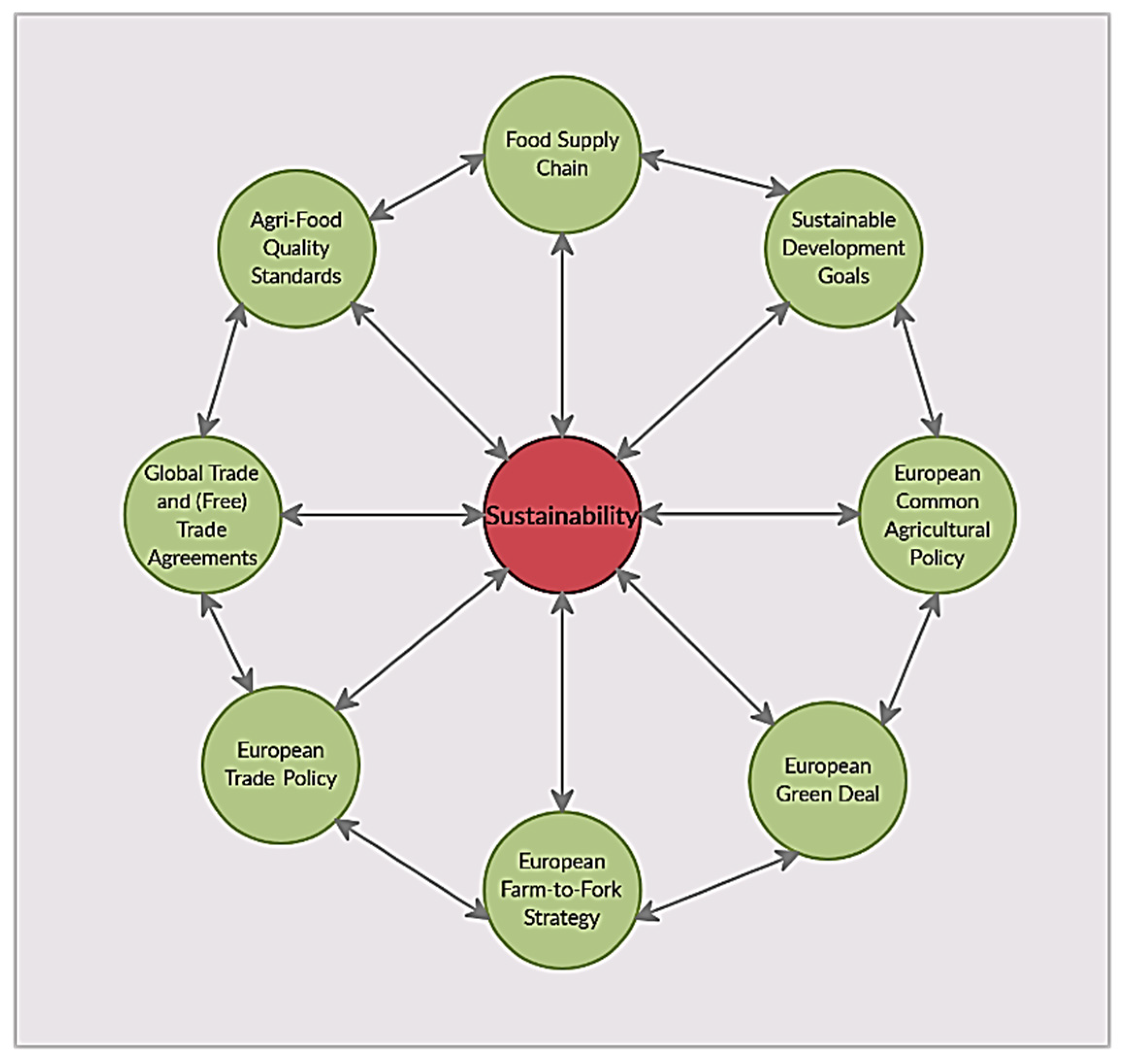
References
- European Commission. Agri-Food Markets. Available online: https://agridata.ec.europa.eu/extensions/DataPortal/agricultural_markets.html (accessed on 22 February 2021).
- European Commission. Trade in Value. Factsheets on EU Countries Agri-Food Trade with the World, Individual Countries and Selected Regions. Available online: https://ec.europa.eu/info/food-farming-fisheries/farming/facts-and-figures/markets/trade/trade-country-region/trade-value_de (accessed on 26 February 2021).
- European Commission. EU Trade Policy. Available online: https://ec.europa.eu/trade/policy/ (accessed on 26 February 2021).
- European Commission. International Affairs—Sanitary and Phytosanitary Measures. Available online: https://ec.europa.eu/food/safety/international_affairs_en (accessed on 26 February 2021).
- European Commission. General Food Law. Available online: https://ec.europa.eu/food/safety/general_food_law_en (accessed on 5 April 2021).
- European Parliament and the Council of the European Union. Regulation (EC) No 178/2002 of the European Parliament and of the Council of 28 January 2002 Laying Down the General Principles and Requirements of Food Law, Establishing the European Food Safety Authority and Laying Down Procedures in Matters of Food Safety. Available online: https://eur-lex.europa.eu/legal-content/EN/ALL/?uri=celex:32002R0178 (accessed on 10 July 2019).
- European Commission. White Paper on Food Safety. COM (1999) 719 Final. Available online: https://ec.europa.eu/food/sites/food/files/safety/docs/gfl_white-paper_food-safety_2000_en.pdf (accessed on 23 August 2020).
- United Nations. United Nations Conference on Trade and Development. International Classification of Non-Tariff Measures—2019 Version. Available online: https://unctad.org/webflyer/international-classification-non-tariff-measures-2019-version (accessed on 29 April 2021).
- Ederington, J.; Ruta, M. Non-Tariff Measures and the World Trading System; Policy Research Working Paper No. 7661; World Bank: Washington, DC, USA, 2016; Available online: https://openknowledge.worldbank.org/handle/10986/24499 (accessed on 29 April 2021).
- United States Trade Representative (USTR). Non-Tariff Barriers and Regulatory Issues. Available online: https://ustr.gov/trade-agreements/free-trade-agreements/transatlantic-trade-and-investment-partnership-t-tip/t-tip-2 (accessed on 29 April 2021).
- Organisation for Economic Co-Operation and Development (OECD). Non-Tariff Measures. Tariffs Are the Tip of the Iceberg: How behind the Border Issues Impact Trade. Available online: https://www.oecd.org/trade/topics/non-tariff-measures/ (accessed on 29 April 2021).
- European Commission. Sustainable Agriculture in the CAP. Available online: https://ec.europa.eu/info/food-farming-fisheries/sustainability/sustainable-cap_en (accessed on 5 April 2021).
- European Commission. Trade for All: European Commission Presents New Trade and Investment Strategy. News on 14 October 2015. Available online: https://trade.ec.europa.eu/doclib/press/index.cfm?id=1381 (accessed on 5 April 2021).
- European Commission. Commissioner Malmström Unveils 15-Point Plan to Make EU Trade and Sustainable Development Chapters More Effective. News on 27 February 2018. Available online: https://trade.ec.europa.eu/doclib/press/index.cfm?id=1803&title=Commissioner-Malmstr%C3%B6m-unveils-15-point-plan-to-make-EU-trade-and-sustainable-development-chapters-more-effective (accessed on 5 April 2021).
- European Commission. Sustainable Development. Available online: https://ec.europa.eu/trade/policy/policy-making/sustainable-development/#_trade-agreements (accessed on 5 April 2021).
- European Commission. The European Commission’s Priorities. Available online: https://ec.europa.eu/info/strategy_en (accessed on 5 April 2021).
- European Commission. Political Guidelines of the Commission 2019–2024. Available online: https://ec.europa.eu/info/sites/default/files/political-guidelines-next-commission_en_0.pdf (accessed on 5 April 2021).
- European Commission. A European Green Deal. Available online: https://ec.europa.eu/info/strategy/priorities-2019-2024/european-green-deal_en (accessed on 5 April 2021).
- European Commission. What Is the European Green Deal? Available online: https://ec.europa.eu/commission/presscorner/api/files/attachment/859152/What_is_the_European_Green_Deal_en.pdf.pdf (accessed on 5 April 2021).
- European Commission. From Farm to Fork. Available online: https://ec.europa.eu/info/strategy/priorities-2019-2024/european-green-deal/actions-being-taken-eu/farm-fork_en (accessed on 5 April 2021).
- European Commission. Farm to Fork Strategy for a Fair, Healthy and Environmentally-Friendly Food System. Available online: https://ec.europa.eu/food/farm2fork_en (accessed on 5 April 2021).
- Jarzębowski, S. Integration of Food Supply Chain as an Element of Efficiency of Food Processing Industry; Warsaw University of Life Sciences: Warsaw, Poland, 2013. [Google Scholar]
- Lambert, D.M.; Cooper, M.C. Issues in supply chain management. Ind. Mark. Manag. 2000, 29, 65–83. [Google Scholar] [CrossRef]
- Christopher, M. Logistics and Supply Chain Management: Strategies for Reducing Cost and Improving Service, 2nd ed.; Financial Times Pitman Publishing: London, UK, 1998. [Google Scholar] [CrossRef]
- Van der Vorst, J. Effective Food Supply Chains; Generating, Modelling and Evaluating Supply Chain Scenarios; Wageningen University: Wageningen, The Netherlands, 2000. [Google Scholar]
- Tietenberg, T.L.; Lewis, L. Environmental & Natural Resource Economics, 9th ed.; Pearson Education: Boston, MA, USA, 2009. [Google Scholar]
- Kashmania, R.; Keenan, C.; Wells, R. Corporate environmental leadership: Drivers, characteristics, and examples. Environ. Qual. Manag. 2010, 19, 1–20. [Google Scholar] [CrossRef]
- Jarzębowski, S.; Bourlakis, M.; Bezat-Jarzębowska, A. Short Food Supply Chains (SFSC) as Local and Sustainable Systems. Sustainability 2020, 12, 4715. [Google Scholar] [CrossRef]
- Castillo, V.E.; Mollenkopf, D.A.; Bell, J.E.; Bozdogan, H. Supply Chain Integrity: A Key to Sustainable Supply Chain Management. J. Bus. Logist. 2018, 39, 38–56. [Google Scholar] [CrossRef]
- Elkington, J. Cannibals with Forks: The Triple Bottom Line of the 21st Century; Capstone Publishing Limited: Oxford, UK, 1997. [Google Scholar]
- Elkington, J. Enter the Triple Bottom Line. In The Triple Bottom Line: Does It All Add Up? Henriques, A., Richardson, J., Eds.; Earthscan: London, UK; Sterling, VA, USA, 2004; pp. 1–16. [Google Scholar]
- Orlitzky, M.; Schmidt, F.L.; Rynes, S.L. Corporate Social and Financial Performance: A Meta-Analysis. Organ. Stud. 2003, 24, 403–441. [Google Scholar] [CrossRef]
- Carter, C.R.; Rogers, D.S. A Framework of Sustainable Supply Chain Management: Moving Toward New Theory. Int. J. Phys. Distrib. Logist. Manag. 2008, 38, 360–387. [Google Scholar] [CrossRef]
- Golicic, S.L.; Smith, C.D. A Meta-Analysis of Environmentally Sustainable Supply Chain Management Practices and Firm Performance. J. Supply Chain. Manag. 2013, 49, 78–95. [Google Scholar] [CrossRef]
- Waller, M.A.; Fawcett, S.E.; Johnson, J.L. The Luxury Paradox: How Systems Thinking and Supply Chain Collaboration Can Bring Sustainability into Mainstream Practice. J. Bus. Logist. 2015, 36, 303–305. [Google Scholar] [CrossRef]
- Pagell, M.; Wiengarten, F.; Fynes, B. Institutional Effects and the Decision to Make Environmental Investments. Int. J. Prod. Res. 2013, 51, 427–446. [Google Scholar] [CrossRef]
- Carter, C.R.; Easton, P.L. Sustainable supply chain management: Evolution and future directions. Int. J. Phys. Distrib. Logist. Manag. 2011, 41, 46–62. [Google Scholar] [CrossRef]
- Galli, F.; Brunori, G. (Eds.) Short Food Supply Chains as Drivers of Sustainable Development. Evidence Document; Document developed in the framework of the FP7 project FOODLINKS (GA No. 265287); Laboratorio di studi rurali Sismondi: Pisa, Italy, 2013. [Google Scholar]
- Jarzębowski, S.; Pietrzyck, K. The concept of short supply chains in the food economy. In Proceedings of the International Scientific Conference on the Common Agricultural Policy for the European Union—The Present and the Future, Stare Jabłonki, Poland, 5–7 December 2017; Multi-Annual Programme 2015–2019, no 73.1. Wigier, M., Kowalski, A., Eds.; Institute of Agricultural and Food Economics, National Research Institute: Warsaw, Poland, 2019; pp. 196–208. [Google Scholar] [CrossRef]
- Malak-Rawlikowska, A.; Majewski, E.; Wąs, A.; Borgen, S.O.; Csillag, P.; Donati, M.; Freeman, R.; Hoàng, V.; Lecoeur, J.-L.; Mancini, M.C.; et al. Measuring the Economic, Environmental, and Social Sustainability of Short Food Supply Chains. Sustainability 2019, 11, 4004. [Google Scholar] [CrossRef] [Green Version]
- International Monetary Fund. Global Trade Liberalization and the Developing Countries. IMF Issues Brief 01/08. November 2001. Available online: https://www.imf.org/external/np/exr/ib/2001/110801.htm (accessed on 30 July 2021).
- World Bank Group. Stronger Open Trade Policies Enable Economic Growth for All. Results Briefs 3 April 2018. Available online: https://www.worldbank.org/en/results/2018/04/03/stronger-open-trade-policies-enables-economic-growth-for-all (accessed on 30 July 2021).
- United Nations. International Trade in Developing Economies. Available online: https://sdgpulse.unctad.org/trade-developing-economies/# (accessed on 30 July 2021).
- European Commission. Trade as a Driver of Prosperity. Commission Staff Working Document Accompanying the Communication on Trade, Growth and World Affairs. Trade Policy as a Core Component of the EU’s 2020 Strategy. SEC (2010) 1269 Final, 9 November 2010. Available online: http://aei.pitt.edu/38023/ (accessed on 30 July 2021).
- Porter, M.E.; van der Linde, C. Green and Competitive: Ending the Stalemate. Harv. Bus. Rev. 1995, 73, 120–134. Available online: https://hbr.org/1995/09/green-and-competitive-ending-the-stalemate (accessed on 19 June 2021).
- Kleindorfer, P.R.; Singhal, K.; Van Wasssenhove, L.N. Sustainable Operations Management. Prod. Oper. Manag. 2005, 14, 482–492. [Google Scholar] [CrossRef]
- Pagell, M.; Wu, Z. Building a More Complete Theory of Sustainable Supply Chain Management Using Case Studies of 10 Exemplars. J. Supply Chain. Manag. 2009, 45, 37–56. [Google Scholar] [CrossRef]
- Reuter, C.; Foerstl, K.; Hartmann, E.; Blome, C. Sustainable Global Supplier Management: The Role of Dynamic Capabilities in Achieving Competitive Advantage. J. Supply Chain. Manag. 2010, 46, 45–63. [Google Scholar] [CrossRef]
- Thornton, L.M.; Autry, C.W.; Gligor, D.M.; Brik, A.B. Does Socially Responsible Supplier Selection Pay Off for Customer Firms? A Cross-Cultural Comparison. J. Supply Chain. Manag. 2013, 49, 66–89. [Google Scholar] [CrossRef]
- Beckman, J.; Ivanic, M.; Jelliffe, J.L.; Baquedano, F.G.; Scott, S.G. Economic and Food Security Impacts of Agricultural Input Reduction Under the European Union Green Deal’s Farm to Fork and Biodiversity Strategies; EB-30; U.S. Department of Agriculture, Economic Research Service: Washington, DC, USA, 2020. Available online: https://www.ers.usda.gov/publications/pub-details/?pubid=99740 (accessed on 5 June 2021).
- Grübler, J.; Stöllinger, R.; Tondl, G. Are EU Trade Agreements in Line with the European Green Deal? Available online: https://wiiw.ac.at/are-eu-trade-agreements-in-line-with-the-european-green-deal-n-484.html (accessed on 5 June 2021).
- Kettunen, M.; Bodin, E.; Davey, E.; Gionfra, S.; Charveriat, C. An EU Green Deal for Trade Policy and the Environment: Aligning Trade with Climate and Sustainable Development Objectives; Institute for European Environmental Policy (IEEP): Brussels, Belgium; London, UK, 2020; Available online: https://eu.boell.org/en/2020/02/06/eu-green-deal-trade-policy-and-environment (accessed on 5 June 2021).
- Dupré, M.; European Trade Policy and the Green Deal. Green Eur. J. 2020. Available online: https://www.greeneuropeanjournal.eu/european-trade-policy-and-the-green-deal/ (accessed on 5 June 2021).
- Schrauwen, A. A Geopolitical Commission, a European Green Deal and Trade’. Leg. Issues Econ. Integr. 2020, 47, 1–7. Available online: https://hdl.handle.net/11245.1/95dd4684-e0f4-4177-a6b4-0bdd393b4a35 (accessed on 5 June 2021).
- Schebesta, H.; Candel, J.J.L. Game-changing potential of the EU’s Farm to Fork Strategy. Nat. Food 2020, 1, 586–588. [Google Scholar] [CrossRef]
- Grimm, S.; Reiners, W.; Helwig, N.; Siddi, M.; Mourier, L. The Global Dimension of the European Green Deal: The EU as a Green Leader? The Multinational Development Policy Dialogue, KAS: Brussels, Belgium, 2021; Available online: https://www.die-gdi.de/en/others-publications/article/the-global-dimension-of-the-european-green-deal-the-eu-as-a-green-leader/ (accessed on 5 June 2021).
- Wolf, S.; Teitge, J.; Mielke, J.; Schütze, F.; Jaeger, C. The European Green Deal—More Than Climate Neutrality. Intereconomics 2021, 56, 99–107. [Google Scholar] [CrossRef] [PubMed]
- Fuchs, R.; Brown, C.; Rounsevell, M. Europe’s Green Deal offshores environmental damage to other nations. Nature 2020, 586, 671–673. [Google Scholar] [CrossRef]
- Siddi, M. The European Green Deal: Assessing Its Current State and Future Implementation. FIIA Working Paper 114. Finnish Institute of International Affairs: Helsinki, Finland, 2020. Available online: https://www.fiia.fi/en/publication/the-european-green-deal (accessed on 5 June 2021).
- European Commission. Sustainable Development Goals. Available online: https://ec.europa.eu/info/strategy/international-strategies/sustainable-development-goals_en (accessed on 5 April 2021).
- United Nations. 17 Goals to Transform Our World. Available online: https://www.un.org/sustainabledevelopment/ (accessed on 5 April 2021).
- United Nations. Department of Economic and Social Affairs. Sustainable Development. The 17 Goals. Available online: https://sdgs.un.org/goals (accessed on 5 April 2021).
- European Commission. Towards a Sustainable Food System. Available online: https://ec.europa.eu/info/research-and-innovation/strategy/support-policy-making/scientific-support-eu-policies/group-chief-scientific-advisors/towards-sustainable-food-system_en (accessed on 5 April 2021).
- Westhoek, H.; DG SANTE, European Commission. EU Farm to Fork Strategy: Promoting Sustainable Food Consumption and Facilitating the Shift to Healthy, Sustainable Diets. Presentation at Online-Webinar by Valumics: Putting Solutions on the Table. Successful Approaches and Interventions to Support more Sustainable Food Consumption Behaviors in the EU. 16 July 2020. Available online: https://valumics.eu/events/ (accessed on 5 April 2021).
- El Bilali, H.; Strassner, C.; Ben Hassen, T. Sustainable Agri-Food Systems: Environment, Economy, Society, and Policy. Sustainability 2021, 13, 6260. [Google Scholar] [CrossRef]
- Association of German Chambers of Industry and Commerce e.V. The German Chambers of Commerce Abroad. Available online: https://www.ahk.de/en/ (accessed on 7 April 2021).
- Association of German Chambers of Industry and Commerce e.V. AHK Annual Report 2019. Available online: https://www.ahk.de/fileadmin/DEinternational/AHK_JB19_A4_Quer_RZ_a12-ONLINE_ENGLISH__1_.pdf (accessed on 7 April 2021).
- German Federal Ministry for Economic Affairs and Energy (BMWi). Promotion for Foreign Trade and Invest. Available online: https://www.bmwi.de/Navigation/EN/Topic/topic.html?cl2Categories_LeadKeyword=au%C3%9Fenwirtschaftsfoerderung (accessed on 7 April 2021).
- Association of German Chambers of Industry and Commerce e.V. AHK World Business Outlook—Spring 2021. Available online: https://www.dihk.de/resource/blob/53220/cfc21a22a651745c6b33155100e1fcfc/ahk-world-business-outlook-fruehjahr-2021englisch-data.pdf (accessed on 7 June 2021).
- Association of German Chambers of Industry and Commerce e.V. German American Chambers of Commerce. Available online: https://www.ahk.de/en/usa (accessed on 7 April 2021).
- Association of German Chambers of Industry and Commerce e.V. International Affairs. Available online: https://www.dihk.de/de/themen-und-positionen/internationales (accessed on 10 April 2021). (In German).
- Representative of German Industry and Trade (RGIT). Trade. Available online: https://www.rgit-usa.com/en/issues/trade/ (accessed on 10 April 2021).
- Pilgrim, M.; Meier, R. National Chambers of Commerce: A Primer on the Organization and Role of Chamber Systems; Center for International Private Enterprise (CIPE): Washington, DC, USA, 1995. [Google Scholar]
- Carlsson, U. (Ed.) Understanding Media and Information Literacy (MIL) in the Digital Age. A Question of Democracy; Department of Journalism, Media and Communication (JMG), University of Gothenburg: Göteborg, Sweden, Published 2019 by the UNESCO Chair on Freedom of Expression, Media Development and Global Policy; Available online: https://www.gu.se/jmg/understanding-media-and-information-literacy-mil-in-the-digital-age (accessed on 10 April 2021).
- Dalkey, N.C. The Delphi Method: An Experimental Study of Group Opinion; The RAND Corporation: Santa Monica, CA, USA, 1969; Available online: https://www.rand.org/pubs/research_memoranda/RM5888.html (accessed on 13 September 2021).
- Hasson, F.; Keeney, S. Enhancing rigour in the Delphi technique research. Technol. Forecast. Soc. Chang. 2011, 78, 1695–1704. [Google Scholar] [CrossRef]
- Hasson, F.; Keeney, S.; McKenna, H. Research guidelines for the Delphi survey technique. J. Adv. Nurs. 2000, 32, 1008–1015. [Google Scholar] [CrossRef] [Green Version]
- Okoli, C.; Pawlowski, S.D. The Delphi method as a research tool: An example, design considerations and applications. Inf. Manag. 2004, 42, 15–29. [Google Scholar] [CrossRef] [Green Version]
- Auerbach, C.F.; Silverstein, L.B. Qualitative Data: An Introduction to Coding and Analysis; New York University Press: New York, NY, USA, 2003. [Google Scholar]
- de Vreese, C.H. News Framing: Theory and Typology. Inf. Des. J. 2005, 13, 51–62. [Google Scholar] [CrossRef]
- Prat, A.; Strömberg, D. The Political Economy of Mass Media; Discussion Paper No. 8246; Centre for Economic Policy Research: London, UK, 2011; Available online: https://cepr.org/active/publications/discussion_papers/dp.php?dpno=8246 (accessed on 28 August 2019).
- Varner, I.I. The Theoretical Foundation for Intercultural Business Communication: A Conceptual Model. J. Bus. Commun. 2000, 37, 39–57. [Google Scholar] [CrossRef]
- Jameson, D.A. Reconceptualizing Cultural Identity and Its Role in Intercultural Business Communication. J. Bus. Commun. 2007, 44, 199–235. [Google Scholar] [CrossRef]
- Lauring, J.; Jonasson, C. Language use and communication in an international management setting: The power to misrecognize. HERMES J. Lang. Commun. Bus. 2017, 23, 199–208. [Google Scholar] [CrossRef] [Green Version]
- Amann, B.; Jaussaud, J. (Eds.) Cross-Cultural Challenges in International Management, 1st ed.; Routledge: New York, NY, USA, 2020. [Google Scholar] [CrossRef]
- Bausch, M.; Barmeyer, C.; Mayrhofer, U. Cultural challenges and quality management practices of a German multinational in Brazil. In Cross-Cultural Challenges in International Management, 1st ed.; Amann, B., Jaussaud, J., Eds.; Routledge: New York, NY, USA, 2020; pp. 74–93. [Google Scholar] [CrossRef]
- Raab, V.; Petersen, B. Strengthening of the international dialog between industry and academia. In Quality and Risk Management in Agri-Food Chains; Petersen, B., Nüssel, M., Hamer, M., Eds.; Wageningen Academic Publishers: Wageningen, The Netherlands, 2014; pp. 266–271. [Google Scholar]
- Education and Qualification Alliance SCE. Internationalisation. Available online: https://www.eqasce.eu/internationalization/ (accessed on 5 March 2021).
- Education and Qualification Alliance SCE. EQA Qualification Programs. Available online: https://www.eqasce.eu/eqa-qualification-programs/ (accessed on 5 March 2021).
- FAO. COVID-19 and the Risk to Food Supply Chains: How to Respond? FAO: Rome, Italy, 2020. [Google Scholar] [CrossRef]
- Rivera-Ferre, M.G.; López-i-Gelats, F.; Ravera, F.; Oteros-Rozas, E.; di Masso, M.; Binimelis, R.; El Bilali, H. The two-way relationship between food systems and the COVID19 pandemic: Causes and consequences. Agric. Syst. 2021, 191, 103134. [Google Scholar] [CrossRef]
- Deconinck, K.; Avery, E.; Jackson, L.A. Food Supply Chains and Covid-19: Impacts and Policy Lessons. EuroChoices 2019, 19, 34–39. [Google Scholar] [CrossRef]
- Chen, K.Z.; Mao, R. Fire lines as fault lines: Increased trade barriers during the COVID-19 pandemic further shatter the global food system. Food Secur. 2020, 12, 735–738. [Google Scholar] [CrossRef] [PubMed]
- Pietrzyck, K.; Berke, N.; Wendel, V.; Steinhoff-Wagner, J.; Jarzębowski, S.; Petersen, B. Understanding the Importance of International Quality Standards Regarding Global Trade in Food and Agricultural Products: Analysis of the German Media. Agriculture 2021, 11, 328. [Google Scholar] [CrossRef]
- Fleming, T. Models of Lifelong Learning: An Overview. In The Oxford Handbook of Lifelong Learning, 2nd ed.; London, M., Ed.; Oxford University Press: Oxford, UK, 2020. [Google Scholar] [CrossRef]
- Quendler, E.; Lamb, M.J.; Driouech, N. Sustainable Education, Employability, and Job Prospects for Next Generations in the Digital Era. In The Oxford Handbook of Lifelong Learning, 2nd ed.; London, M., Ed.; Oxford University Press: Oxford, UK, 2020. [Google Scholar] [CrossRef]
- Maclean, R.; Ordonez, V. Work, skills development for employability and education for sustainable development. Educ. Res. Policy Prac. 2007, 6, 123–140. [Google Scholar] [CrossRef]
- European Union. Eurostat Statistics Explained. Glossary: Enterprise size. Available online: https://ec.europa.eu/eurostat/statistics-explained/index.php?title=Glossary:Enterprise_size (accessed on 7 March 2021).
- Lozowicka, B.; Kaczyński, P.; Rutkowska, E.; Jankowska, M.; Hrynko, I. Evaluation of pesticide residues in fruit from Poland and health risk assessment. Agric. Sci. 2013, 4, 106–111. [Google Scholar] [CrossRef] [Green Version]
- United States Department of Agriculture. Foreign Agricultural Service (FAS). Stone Fruit Annual 2018. GAIN Report Number SP1820, 2018. Available online: https://apps.fas.usda.gov/newgainapi/api/Report/DownloadReportByFileName?fileName=Stone%20Fruit%20Annual_Madrid_EU-28_8-24-2018 (accessed on 28 August 2019).
- Pietrzyck, K.; Petersen, B.; Jarzębowski, S. The Role of Quality Management in the Context of the Transatlantic Trade and Investment Partnership (TTIP): The Case of the Polish Agri-Food Sector. Int. J. Probl. Agric. Econ. 2018, 3, 94–110. [Google Scholar] [CrossRef]
- Lehnert, S.; Schütz, V.; Nüssel, M. Development of quality strategies in complex customer–supplier relationships. In Quality and Risk Management in Agri-Food Chains; Petersen, B., Nüssel, M., Hamer, M., Eds.; Wageningen Academic Publishers: Wageningen, The Netherlands, 2014; pp. 39–43. [Google Scholar]
- European Commission. Commission Expert Group on Trade and Sustainable Development (E03013). Available online: https://ec.europa.eu/transparency/expert-groups-register/screen/expert-groups/consult?lang=en&groupID=3013 (accessed on 5 April 2021).
- European Commission. Remarks by Executive Vice-President Dombrovskis on the Trade Policy Review Communication at the European Parliament’s International Trade Committee. Speech on 24 February 2021. Available online: https://ec.europa.eu/commission/presscorner/detail/en/speech_21_817 (accessed on 5 April 2021).
- European Commission. Trade Policy Review. An Open, Sustainable and Assertive Trade Policy. Available online: https://trade.ec.europa.eu/doclib/docs/2021/april/tradoc_159541.0270_EN_05.pdf (accessed on 26 April 2021).
- Pietrzyck, K.; Steinhoff-Wagner, J.; Jarzębowski, S.; Petersen, B. Building Bridges—International Quality Management of the Agri-Food Industry on Global Markets—Reflecting Free Trade Agreements: TTIP as an Example. In Heutige und zukünftige Herausforderungen an die Qualitätswissenschaft in Forschung und Praxis, Proceedings of the GQW-Jahrestagung, Erlangen, Germany, 2–3 March 2017; Otten, H., Götz, J., Pollak, S., Eds.; FAU University Press: Erlangen, Germany, 2017; pp. 185–208. (In German) [Google Scholar]
- Pietrzyck, K.; Driouech, N.; Petersen, B. The Transatlantic Trade and Investment Partnership (TTIP): Threat or an opportunity for EU-Mediterranean agriculture and agri-food sector? An exploratory survey. In Proceedings of the International Scientific Conference on the Common Agricultural Policy for the European Union—The Present and the Future, Stare Jabłonki, Poland, 5–7 December 2017; Multi-Annual Programme 2015–2019, no 73.1. Wigier, M., Kowalski, A., Eds.; Institute of Agricultural and Food Economics, National Research Institut: Warsaw, Poland; pp. 177–195. [Google Scholar] [CrossRef]
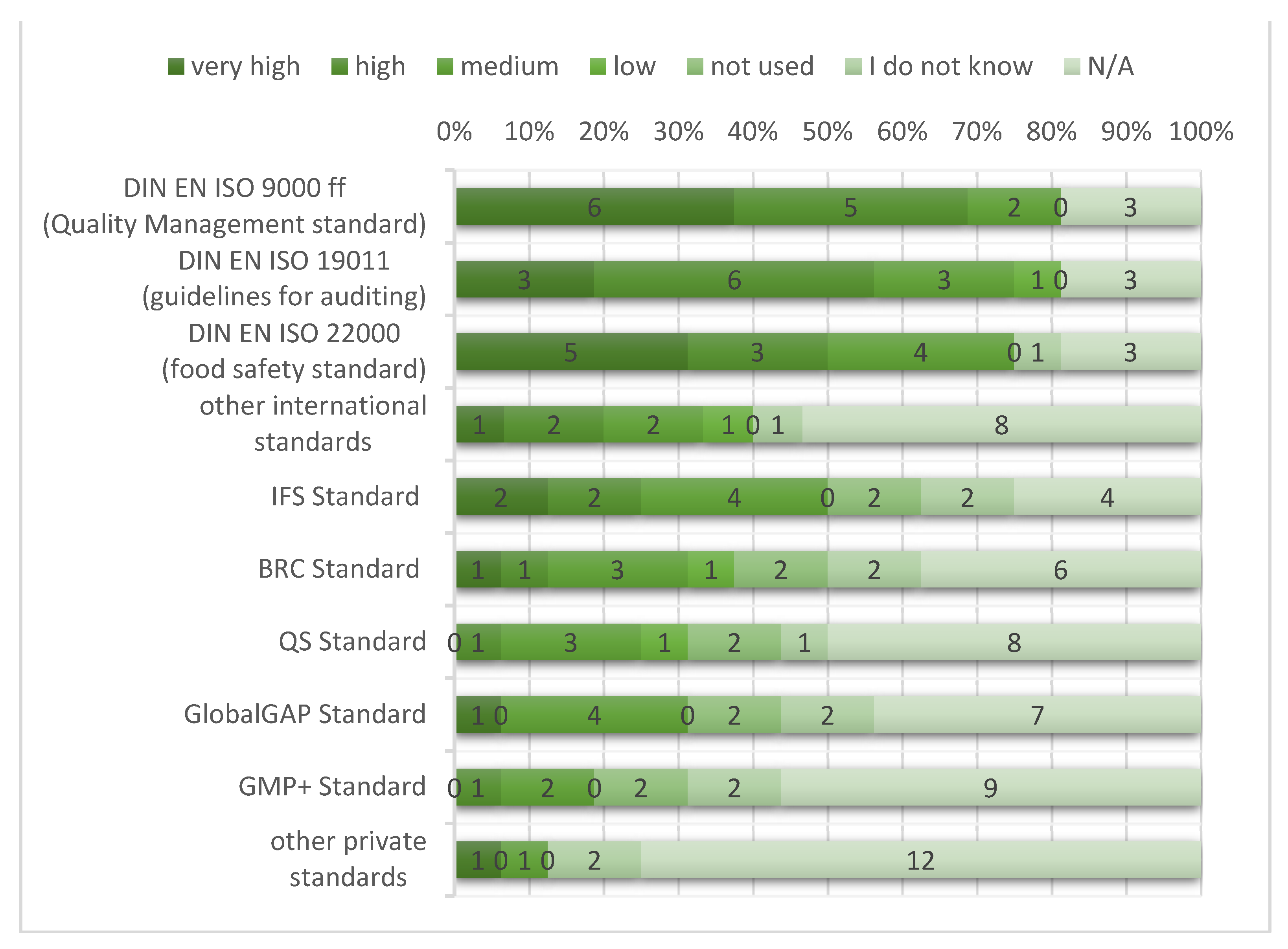
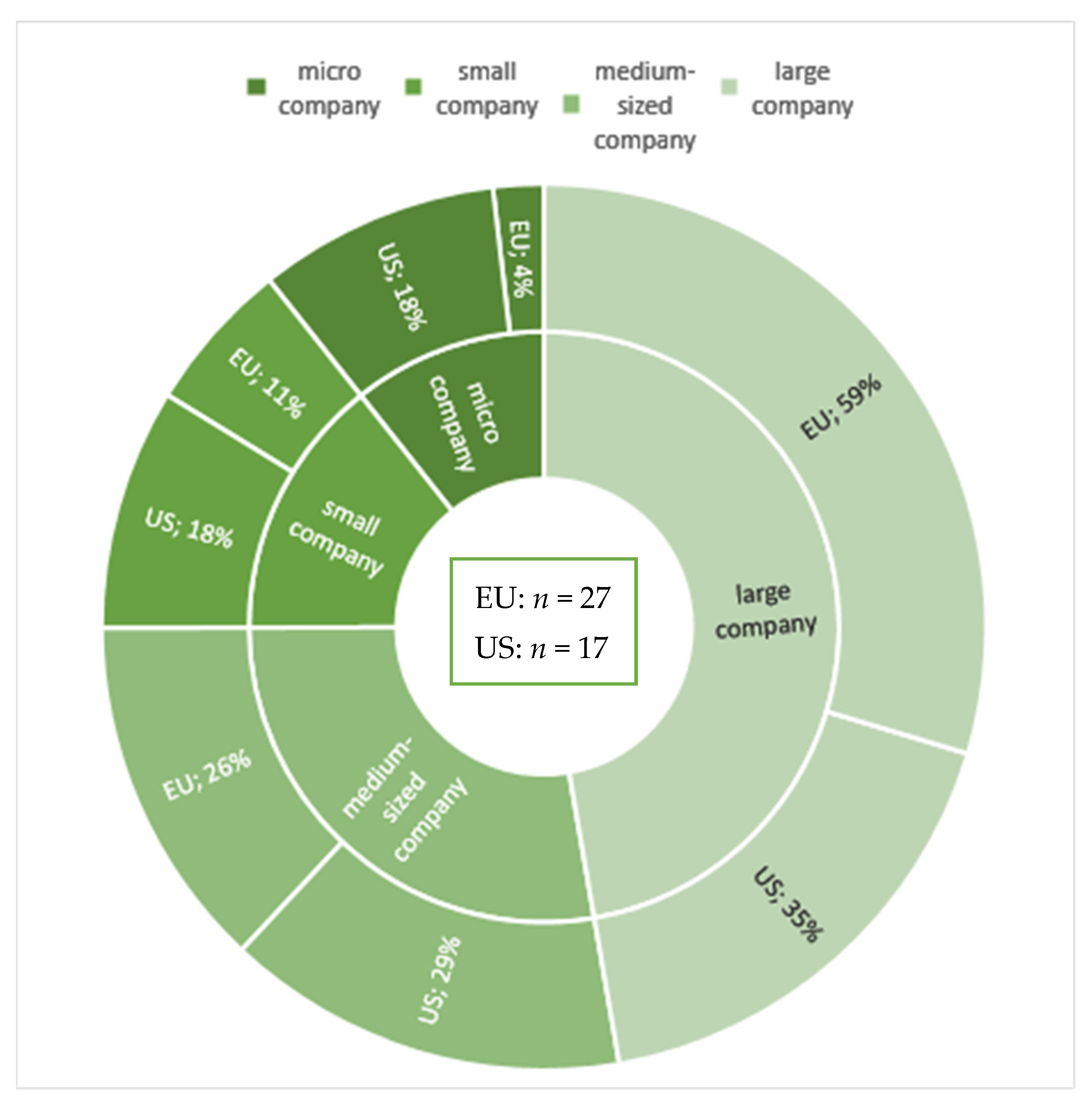
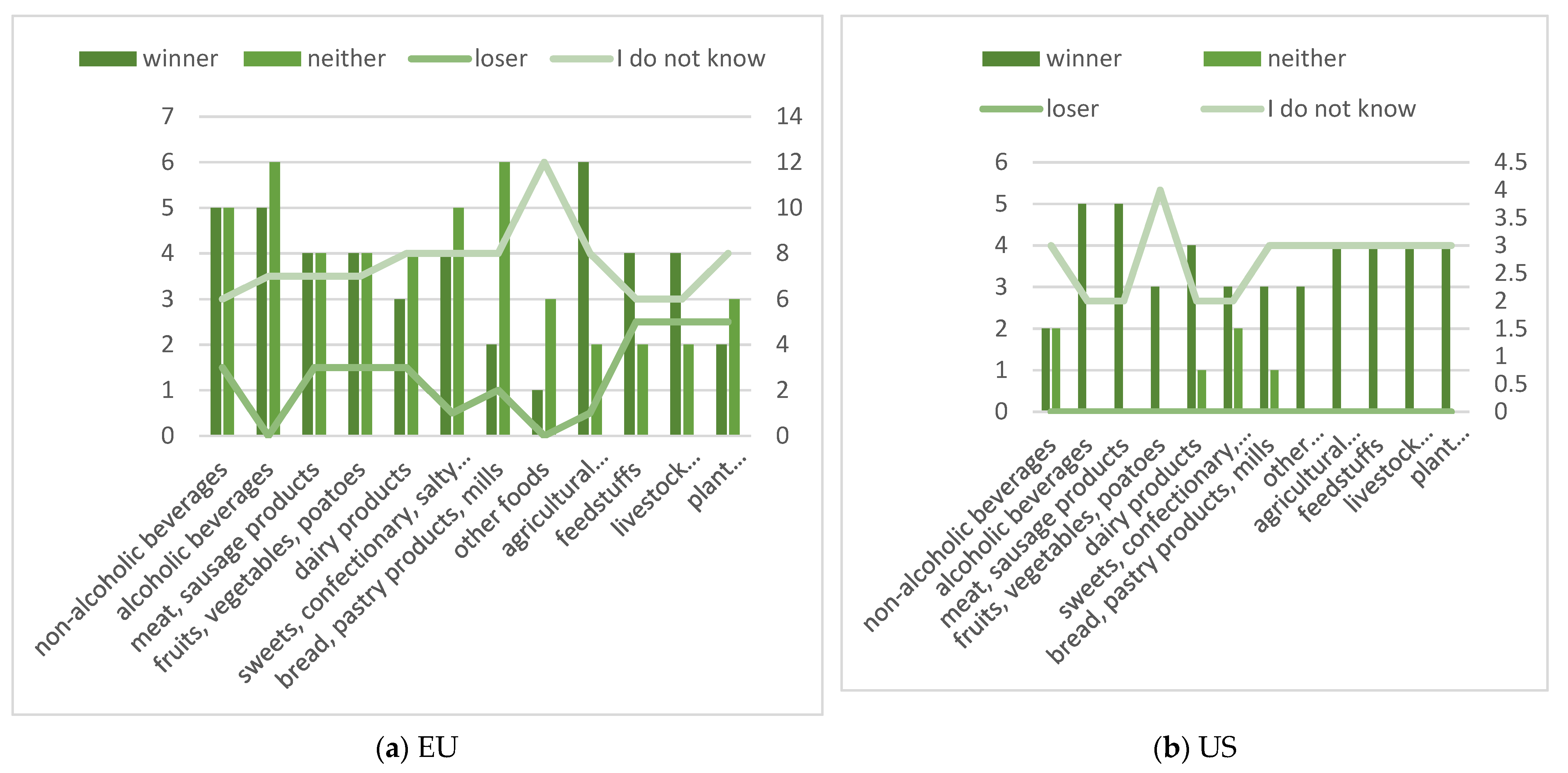
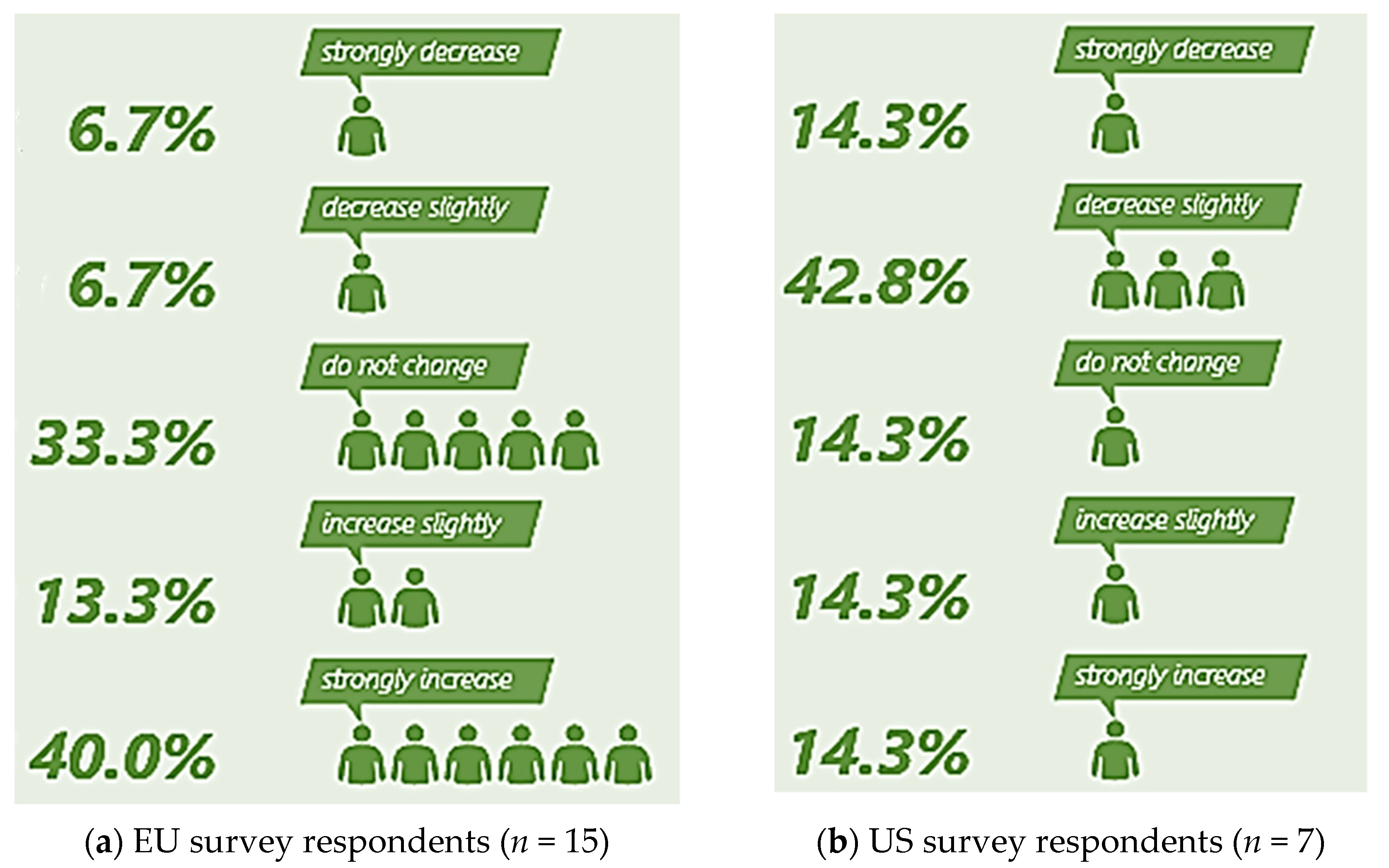
| Practices in the Food Supply Chain | Practices in Food Quality Standards | Practices in Global Trade |
|---|---|---|
| Development of a contingency plan (2021) for ensuring the food supply and security in times of crisis | Development of a contingency plan (2021) for ensuring food supply and security in times of crisis | Proposal for the revision of the EU legislation on food contact materials (food safety, environmental footprint; 2022) |
| Develop an EU code and monitoring framework for responsible business and marketing conducted in the FSC (2021) | Stimulate reformulation of standards in processed food (2021/2020) | Proposal to require origin indication for certain products (2022) |
| Revision to EU marketing standards for agricultural, fishery, and aquaculture products to ensure the uptake and supply of sustainable products (2021–2022) | Proposal for the revision of the EU legislation on food contact materials (food safety, environmental footprint; 2022) | Promotion of global transitions caused due to international cooperation |
| Proposal for a sustainable food labeling framework to empower consumers to make sustainable food choices (2024) | Work through international standard-setting bodies (e.g., Codex Alimentarius) | Inclusion of ambitious sustainability chapter, including food, in all EU bilateral trade agreements |
| Proposal to require origin indication for certain products (2022) | Environmental aspects considered when assessing requests for import tolerances (e.g., standards for pesticides) | Environmental aspects considered when assessing requests for import tolerances (e.g., standards for pesticides) |
| Promotion of appropriate labeling schemes—to ensure that food imported into the EU is gradually produced in a sustainable manner | Promotion of appropriate labeling schemes—to ensure that food imported into the EU is gradually produced in a sustainable manner | Promotion of appropriate labeling schemes—to ensure that food imported into the EU is gradually produced in a sustainable manner |
| Sustainable Development Goals | Sustainability Aspects |
|---|---|
 |
|
 |
|
 |
|
| Focus Group | Locations (Potential Participants) | Participated Locations | Quota | Total Participants |
|---|---|---|---|---|
| EU-AHKs | 22 | 13 | 59% | 18 |
| US-AHKs | 5 | 4 | 80% | 6 |
| DIHK | 1 | 1 | 100% | 1 |
| RGIT | 1 | 1 | 100% | 1 |
| Total | 29 | 19 | 65.5% | 26 |
| Level of Information | EU General Public n = 17 | US General Public n = 7 | EU Business Professionals n = 19 | US Business Professionals n = 7 |
|---|---|---|---|---|
| very high | 0% | 0% | 5.3% | 14.3% |
| high | 0% | 0% | 5.3% | 28.6% |
| intermediate | 17.6% | 0% | 36.8% | 57.1% |
| low | 11.8% | 42.9% | 31.6% | 0% |
| very low | 70.6% | 57.1% | 21.0% | 0% |
| Very Good Knowledge | Good Knowledge | Minimal Knowledge | No Knowledge Present | |
|---|---|---|---|---|
| EU companies | - | +++ | +++ | - |
| US companies | + | - | ++ | - |
| A Very Large Role | A Major Role | A Medium Role | A Minor Role | |
|---|---|---|---|---|
| EU: at the moment (n = 16) | 43.75% | 43.75% | 12.5% | 0% |
| US: at the moment (n = 3) | 33.3% | 33.3% | 33.3% | 0% |
| EU: TTIP in force (n = 15) | 20% | 46.67% | 13.3% | 20% |
| US: TTIP in force (n = 4) | 25% | 50% | 0% | 25% |
| Very High Awareness | High Awareness | Neutral Awareness | Low Awareness | Very Low Awareness | n/a | |
|---|---|---|---|---|---|---|
| EU (n = 19) | 0% | 26.3% | 21.1% | 21.1% | 15.8% | 15.8% |
| US (n = 7) | 14.3% | 42.9% | 28.6% | 0% | 0% | 14.3% |
Publisher’s Note: MDPI stays neutral with regard to jurisdictional claims in published maps and institutional affiliations. |
© 2021 by the authors. Licensee MDPI, Basel, Switzerland. This article is an open access article distributed under the terms and conditions of the Creative Commons Attribution (CC BY) license (https://creativecommons.org/licenses/by/4.0/).
Share and Cite
Pietrzyck, K.; Jarzębowski, S.; Petersen, B. Exploring Sustainable Aspects Regarding the Food Supply Chain, Agri-Food Quality Standards, and Global Trade: An Empirical Study among Experts from the European Union and the United States. Energies 2021, 14, 5987. https://doi.org/10.3390/en14185987
Pietrzyck K, Jarzębowski S, Petersen B. Exploring Sustainable Aspects Regarding the Food Supply Chain, Agri-Food Quality Standards, and Global Trade: An Empirical Study among Experts from the European Union and the United States. Energies. 2021; 14(18):5987. https://doi.org/10.3390/en14185987
Chicago/Turabian StylePietrzyck, Katja, Sebastian Jarzębowski, and Brigitte Petersen. 2021. "Exploring Sustainable Aspects Regarding the Food Supply Chain, Agri-Food Quality Standards, and Global Trade: An Empirical Study among Experts from the European Union and the United States" Energies 14, no. 18: 5987. https://doi.org/10.3390/en14185987
APA StylePietrzyck, K., Jarzębowski, S., & Petersen, B. (2021). Exploring Sustainable Aspects Regarding the Food Supply Chain, Agri-Food Quality Standards, and Global Trade: An Empirical Study among Experts from the European Union and the United States. Energies, 14(18), 5987. https://doi.org/10.3390/en14185987







